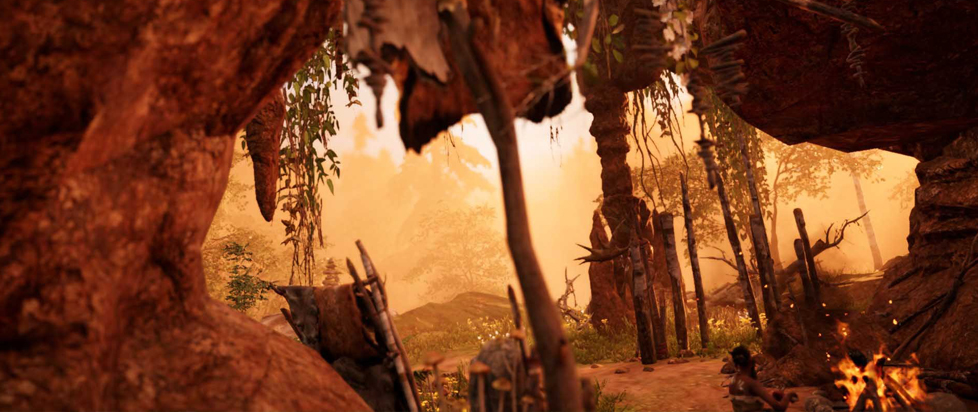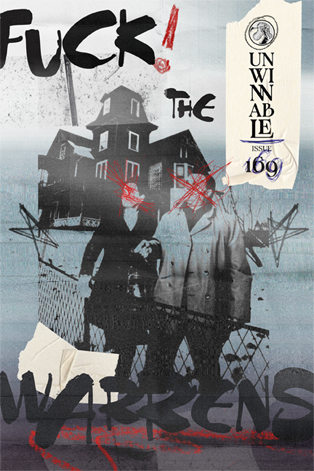
Primal Problems

This column is a reprint from Unwinnable Monthly #169. If you like what you see, grab the magazine for less than ten dollars, or subscribe and get all future magazines for half price.
———
Architecture and games.
———
I’d like to discuss a topic that you’re not likely to ever have come up in regular conversation: the Upper Paleolithic Period. Stretching from around 40,000 to 10,000 years ago, the Upper Paleolithic Period was a pivotal time in human history during which people achieved significant progress in terms of culture, technology and social structure. The leaps and bounds came in the following Neolithic Period, but these all began in the Upper Paleolithic, most notably animal and plant domestication, along with a shift away from hunting and gathering towards sedentarism. The somewhat unloved Far Cry Primal in fact portrays this rather captivating chapter in human history quite well, with a few exceptions.
The architecture of the Upper Paleolithic Period was marked by simplicity, resourcefulness and a close connection to the surrounding environment. This primarily consisted of temporary shelters, communal spaces and possibly simple fortifications. The architecture in Far Cry Primal closely mirrors the structures and techniques used in the Upper Paleolithic Period, providing a pretty good picture of the past. The game features a range of shelters ranging from small, makeshift huts to somewhat more substantial, permanent structures. These dwellings were typically composed of wooden frames, animal hide or bone, materials which provided insulation and protection from the elements, ensuring survival in the unforgiving environments of the Upper Paleolithic Period.
The strategic use of caves represents one of the most iconic features of the architecture from this time, offering protection from the elements and of course predatory animals, including dangerous megafauna. Far Cry Primal accurately represents the use of caves as both shelter and spiritual spaces, highlighting the deep connection between people in the Upper Paleolithic Period and the world around them. These often served as shelters but were also used for artistic expression, most famously in the form of intricate cave paintings, perhaps an early form of religion. People made use of painting for aesthetic value, but also for communication, storytelling and possibly spiritual or ritualistic purposes. The game captures the multifaceted role played by caves, depicting them not only as a form of shelter but as places of substantial cultural significance. You can explore several different caves in Far Cry Primal, discovering various tools and artifacts, along with experiencing some of the cultural practices that were common around the world in the Upper Paleolithic Period.

While this particular point of time in human history was by no means characterized by conflict, you can still see signs of social tension, perhaps even warfare. Far Cry Primal represents this in the form of wooden palisades and fortified outposts, a creative liberty given their scale and complexity, but the game at least conveys the necessity for protection within a hostile world. This aligns with reality, safety and security in the face of potential threats including rival groups and of course predators being a major concern across the board.
Tools were a central part of daily life in the Upper Paleolithic Period, allowing people to hunt, gather and process food, among other things. Far Cry Primal does a pretty good job of capturing the essence of this primitive technology, providing you with a variety of different tools that closely resemble those used in the Upper Paleolithic Period. Stone implements like hand axes, knives, spearheads and scrapers are practically synonymous with the Upper Paleolithic Period and the game accurately portrays the importance of them. Far Cry Primal meticulously recreates a lot of these tools, showcasing their primary role in hunting and processing food, as well as their use for a variety of other common tasks.
The depiction of stone tools in the game is actually one of its bigger selling points, at least in my personal opinion. You can fashion your own stone tools in Far Cry Primal, crafting of course being a fairly common mechanic in videogames these days, but in this particular case, crafting is an effective representation of reality, knapping being an activity practiced by just about everybody in the Upper Paleolithic Period. Far Cry Primal also introduces flint and pyrite as tools for starting fire, faithfully reflecting their importance during the Upper Paleolithic Period. The ability to start and control fire was a defining technological advancement which provided much needed warmth, protection from predators and the ability to cook food. Far Cry Primal successfully captures the significance of these materials, emphasizing them as implements that were absolutely essential for survival, offering a tangible sense of the challenges and innovations that marked the Upper Paleolithic Period.

Far Cry Primal takes all of this a step further by incorporating a crafting and repairing mechanic. This allows players to maintain their tools, mirroring the practices of people during the Upper Paleolithic Period. Stone tools were often reshaped, resharpened or put to other purposes, a necessity given the scarcity of high-quality materials including chert, flint and most famously obsidian. The game forces you to engage in crafting and maintaining tools, reinforcing the need for adaptability and resourcefulness during the Upper Paleolithic Period, offering some insights into the various trials and tribulations of people at the time.
Hunting and also defense were common concerns during the Upper Paleolithic Period, as reflected in the diverse range of weapons available in Far Cry Primal. Spears were of primary importance, but the game depicts a couple of other interesting inventions including the atlatl, a ranged weapon which allowed for greater throwing force and accuracy than a spear. You can make use of spears and atlatls to hunt and fight in Far Cry Primal, accurately showcasing the challenges and techniques involved in the wielding of these weapons.
Bows were highly versatile weapons in the Upper Paleolithic Period, being used for both hunting and combat. Far Cry Primal features a variety of these, each with distinctive characteristics. You can choose from various bows along with several different kinds of arrow, something which accurately represents how much the technology was developed throughout the Upper Paleolithic Period. This actually represents one of the main criteria for dating archaeological sites. In any case, bows required a high level of skill and ability. You have the opportunity to master the bow and arrow in Far Cry Primal, experiencing the precision of what remains a deadly weapon even today. The inclusion of several different kinds of arrowhead allows you to adapt your tactics to different situations, closely mirroring the challenges faced by hunters and warriors during the Upper Paleolithic Period.

The most notable historical discrepancy in Far Cry Primal is the inclusion of pottery and ceramics, materials that were not commonly used in the Upper Paleolithic Period, depicted in substantial quantities throughout the game. This inaccuracy is a surprising departure from the reality of the Upper Paleolithic Period, as pottery and ceramics truly emerged in the much later Neolithic. You might say that people were only just beginning to experiment with pottery in the Upper Paleolithic Period. Far Cry Primal features an abundance of pottery and ceramics, a notable departure from the material record. This may be attributed to the limitations of historical research or the creative liberties taken during development in the name of player experience. I personally think that given the ubiquitousness of ceramics these days, a world without pottery would be difficult to imagine for a lot of people, whether developers or players.
Far Cry Primal offers you a journey back to the Upper Paleolithic Period, a relatively unusual experience in the world of contemporary videogames. Far Cry Primal successfully captures the architecture, tools and weapons that were instrumental to the daily life of people during this pivotal period in human history, allowing you to experience their struggle for survival within a harsher and more unforgiving environment than we currently have in the world around us. The emphasis on shelter construction, tool use and hunting technique provides a remarkably accurate picture of the challenges of life during the Upper Paleolithic Period. The inclusion of pottery and ceramics, materials that were not yet in widespread use at the time, represents a notable departure from our current understanding of the material record, but at the very least, the architecture, tools and weapons give you some insight into the overall experience, bridging the gap between the ancient and modern worlds, teaching players a thing or two about this fascinating and relatively underappreciated chapter in human history.
———
Justin Reeve is an archaeologist specializing in architecture, urbanism and spatial theory, but he can frequently be found writing about videogames, too. You can follow him on Twitter @JustinAndyReeve.




